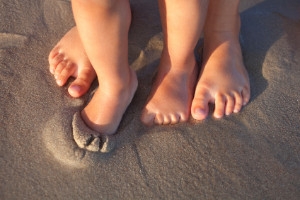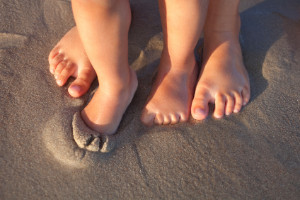
 Babies feet are soft and flexible, and this is a result of bones that have not fully developed. Research has indicated the importance of wearing shoes and socks that fit correctly, and this can help in preventing uncomfortable foot conditions. It is beneficial that children walk barefoot while indoors, and this aids in strengthening the toes which help to provide the grasping motion. It is important to measure children’s feet approximately every other month until the age of three. This will ensure the correct size shoes are worn for their rapidly growing feet. Most babies are born with flat feet, and the arch will fully develop by seven years old. If you notice your child is walking with their feet pointed inward or outward, it is advised that you seek the counsel of a podiatrist who can properly examine your child’s feet.
Babies feet are soft and flexible, and this is a result of bones that have not fully developed. Research has indicated the importance of wearing shoes and socks that fit correctly, and this can help in preventing uncomfortable foot conditions. It is beneficial that children walk barefoot while indoors, and this aids in strengthening the toes which help to provide the grasping motion. It is important to measure children’s feet approximately every other month until the age of three. This will ensure the correct size shoes are worn for their rapidly growing feet. Most babies are born with flat feet, and the arch will fully develop by seven years old. If you notice your child is walking with their feet pointed inward or outward, it is advised that you seek the counsel of a podiatrist who can properly examine your child’s feet.
Making sure that your children maintain good foot health is very important as they grow. If you have any questions, contact Dr.Eji Shobowale of DeNiel Foot & Ankle Center. Our doctor can provide the care you need to keep you pain-free and on your feet.
Keeping Children’s Feet Healthy
Having healthy feet during childhood can help prevent medical problems later in life, namely in the back and legs. As children grow, their feet require different types of care. Here are some things to consider…
Although babies do not walk yet, it is still very important to take care of their feet.
Avoid putting tight shoes or socks on his or her feet.
Allow the baby to stretch and kick his or her feet to feel comfortable.
As a toddler, kids are now on the move and begin to develop differently. At this age, toddlers are getting a feel for walking, so don’t be alarmed if your toddler is unsteady or ‘walks funny’.
As your child gets older, it is important to teach them how to take care of their feet.
Show them proper hygiene to prevent infections such as fungus.
Be watchful for any pain or injury.
Have all injuries checked by a doctor as soon as possible.
Comfortable, protective shoes should always be worn, especially at play.
If you have any questions please feel free to contact our office located in Cypress, TX. We offer the newest diagnostic and treatment technologies for all your foot and ankle needs.
Read more about What to Do to Keep Your Child’s Feet Healthy